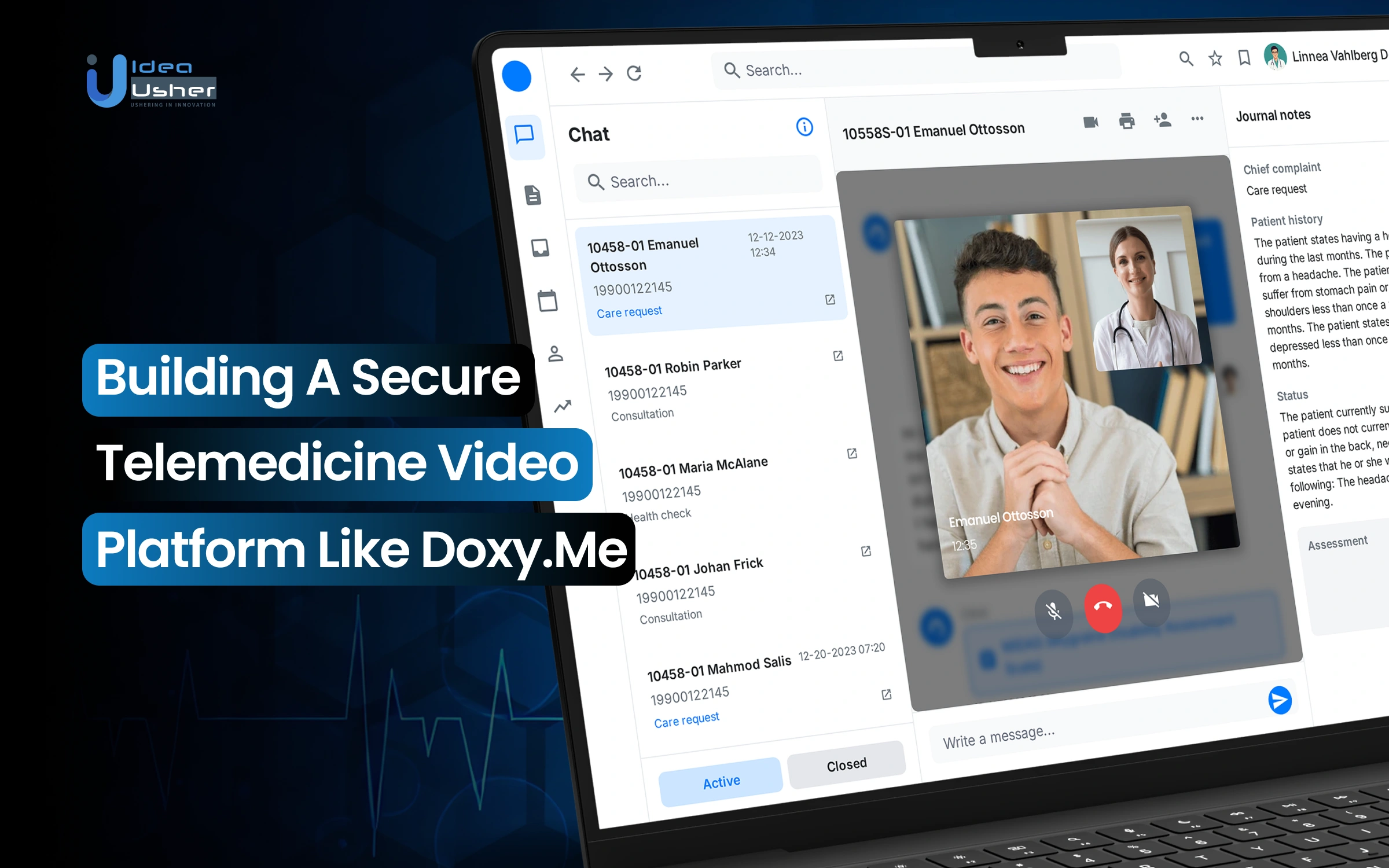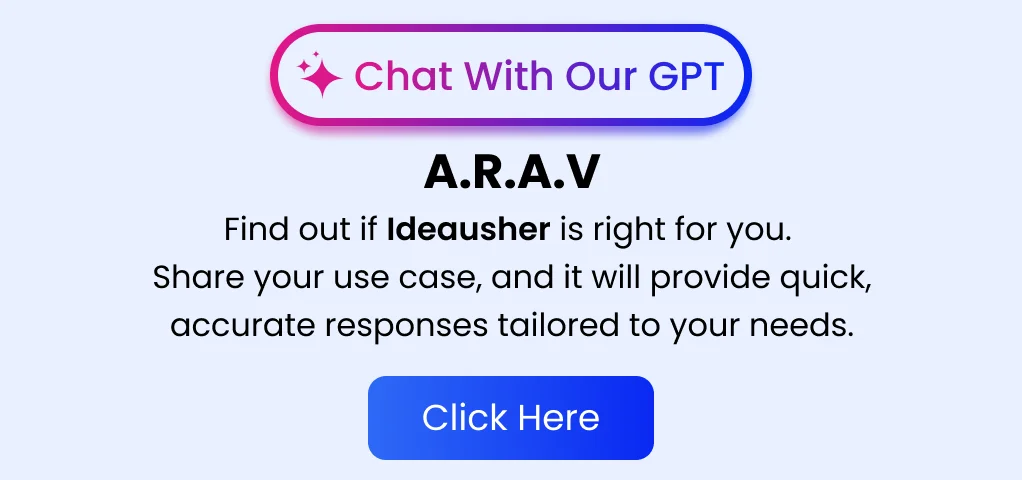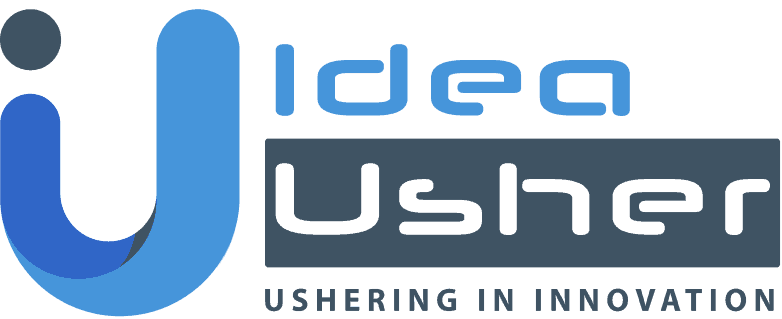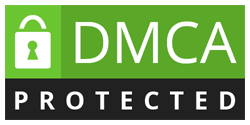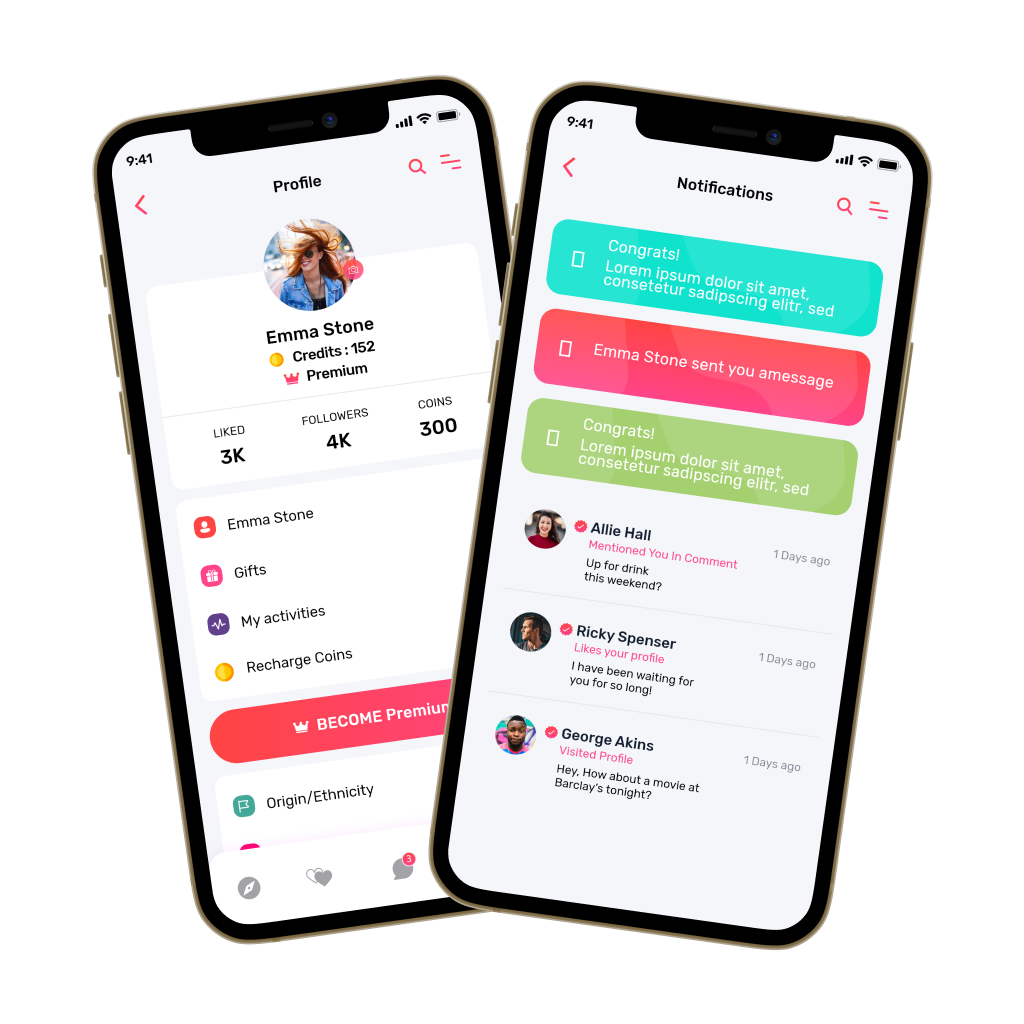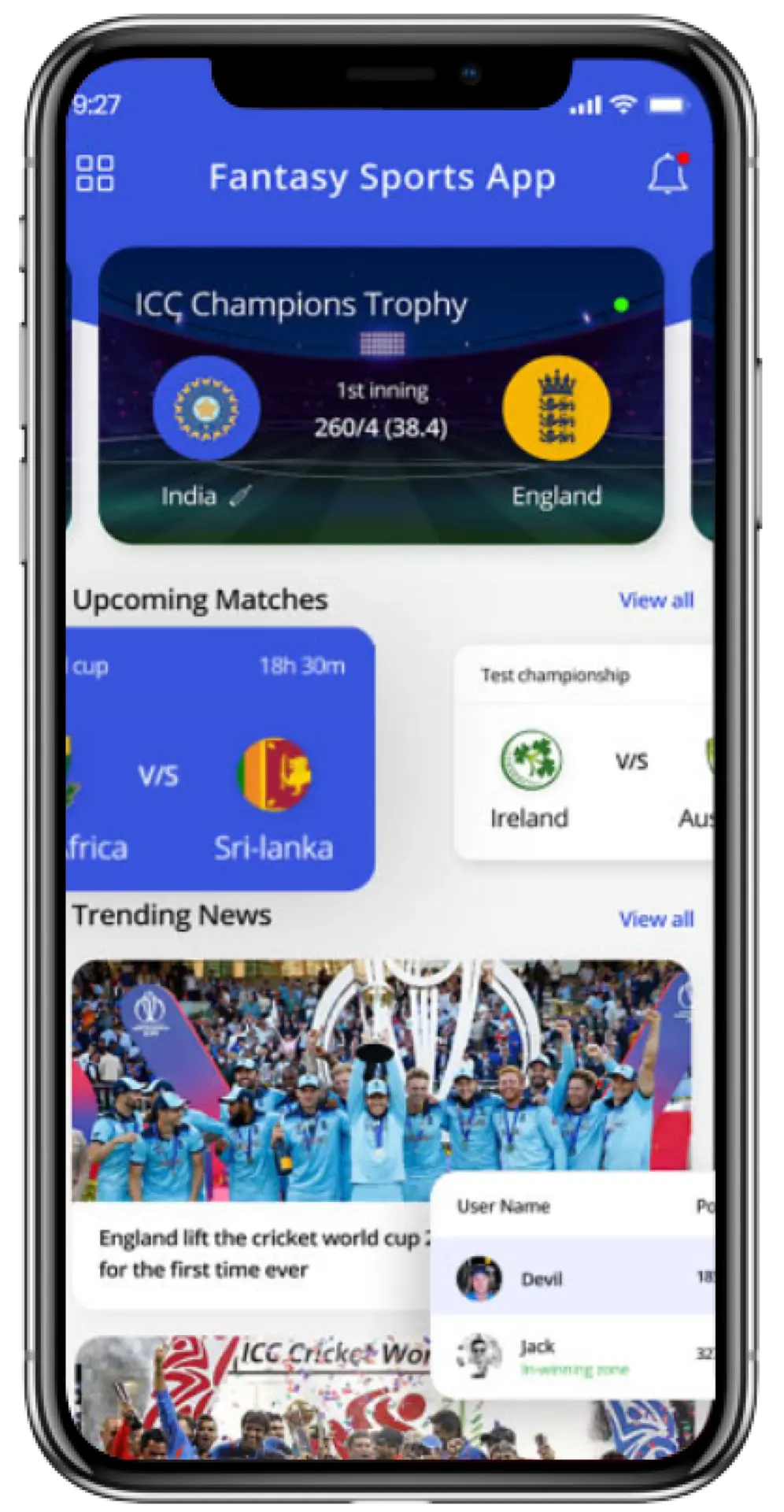Providing healthcare online is now common, but keeping those digital visits safe and smooth is still a big challenge. A telemedicine video platform needs to do more than just connect calls. It has to protect patient privacy, keep connections strong, and meet strict rules like HIPAA and GDPR, all while staying easy for people to use.
That’s where secure and purpose-built platforms like Doxy.me stand out. By blending encryption, real-time communication tools, and healthcare-specific infrastructure, they show how technology can bridge convenience with trust. For healthcare providers alike, these features create the foundation of digital care that patients can truly rely on.
In this blog, we’ll look at what goes into building a secure telemedicine video platform, covering its main structure, important technologies, and the compliance steps that help make it safe and easy for patients to use.
With IdeaUsher’s experience in healthtech innovation, we help businesses turn digital healthcare ideas into reliable, scalable platforms. Our team brings together technical know-how and industry knowledge to create solutions that keep users happy and deliver lasting value.
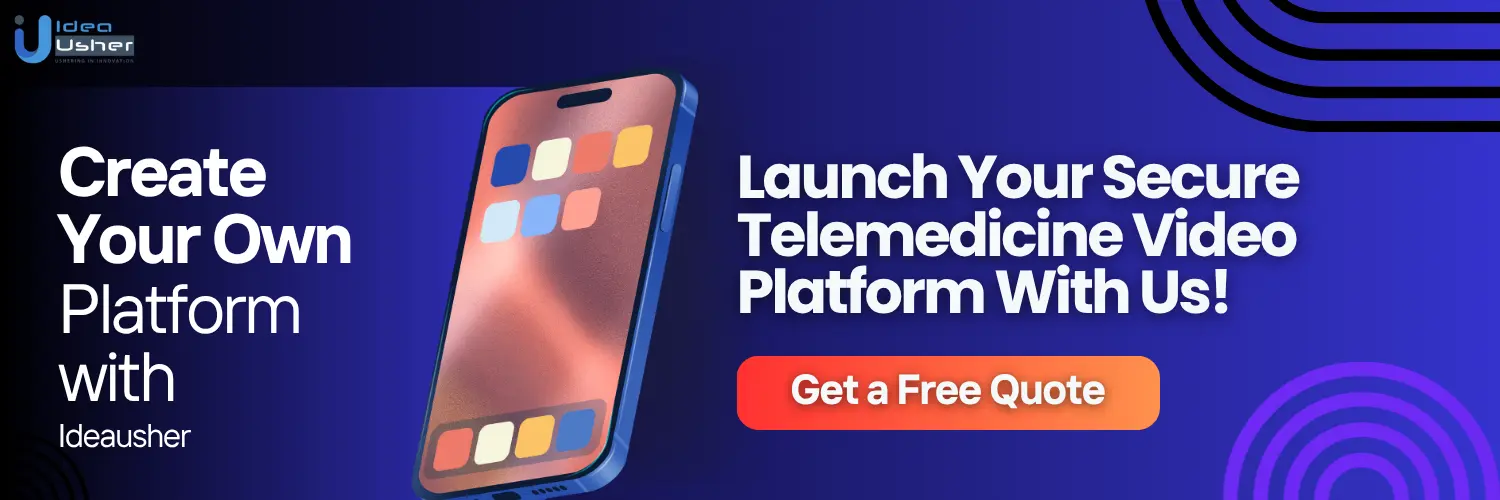
What is a Telemedicine Video Platform, Doxy.me?
Doxy.me is a browser-based telehealth platform built for healthcare providers and patients to interact via video consultation. It was founded in 2013 by Dr. Brandon Welch (then a PhD student) precisely because many clinics, especially in rural or low-resource settings, lacked simple, secure, low-cost tools for remote care.
Its mission is often described as “telemedicine for all,” which means making it easier and more affordable for any provider to connect with patients, no matter where they are.
Business Model Overview
Doxy.me offers a secure telemedicine platform that runs in any web browser, making virtual healthcare more accessible. It is easy to use, allowing healthcare providers to hold video consultations without needing advanced technical skills. About half of users choose the free version, which shows how widely the platform is used and how well the freemium model works.
Revenue Model
Doxy.me uses a tiered subscription model to serve individual providers, small clinics, and large healthcare organizations. Each plan is designed to be affordable and functional, making it easier for different users to adopt telehealth as they grow.
- Free Plan: The Free Plan offers basic telehealth features like end-to-end encryption, browser access without downloads, and unlimited video calls. Perfect for solo practitioners or beginners trying telehealth without upfront costs.
- Professional Plan: The Professional Plan costs $35/month per provider, adding features like invitations, HD video, screen sharing, and payments. It’s ideal for individual providers seeking better patient connection and easier virtual care.
- Clinic Plan: The Clinic Plan costs $50 per provider monthly, suitable for clinics with multiple providers. It includes all Professional Plan features, plus admin controls, analytics, and custom branding, helping clinics manage better and provide a consistent patient experience.
- Enterprise Plan: The Enterprise Plan offers custom pricing for large healthcare organizations with complex needs. It includes dedicated account managers, group training, and customization for seamless large-scale telehealth setup.
How Doxy.me Stands Out?
Here are aspects in which Doxy.me is especially strong compared to many generic telemedicine platforms, based on recent features or evidence:
- Pay during call: Some platforms do not let you collect payment during a video visit from the waiting room. This feature is especially helpful for mental health, therapy, and consultations where immediate payment is needed.
- Meeting history & tracking: Doxy.me records detailed meeting history, including dates and durations. This helps with billing, audits, and follow-ups.
- Interpretation in real-time: On-demand interpreters are now essential worldwide. Doxy.me works with Voyce to provide access to hundreds of languages. This means patients can get real interpreter services during live consultations, not just translated interfaces.
- Low entry barrier: Doxy.me offers a “free forever” plan with basic but useful features. There is no software to install and it is easy to use. This makes it a good choice for places with limited budgets or little tech support.
- Scalability with context: For larger clinics, Doxy.me has a “Clinic” plan that includes shared waiting rooms, admin controls, and branding. These features help keep the experience consistent as the number of providers grows.
Core Functional Components of Doxy.me
Doxy.me is a secure telehealth platform that runs in your browser, simplifying virtual care. Its features facilitate communication, scheduling, and tool integration, making telemedicine easy for patients and providers.
1. Secure Video & Audio Conferencing
Doxy.me enables secure, high-quality video and audio calls directly in browsers via WebRTC, with no app downloads. Patients join through a simple link, use pre-call device checks, and wait in a virtual waiting room before sessions.
2. Appointment Scheduling & Patient Check-In
Providers send appointment invites via email or text, and patients check in through the provider’s waiting room URL. It integrates with tools like Juvonno and Calendly, ensuring smooth scheduling and HIPAA-compliant workflows.
3. EMR/EHR Integration
While not a full EMR system, Doxy.me integrates with platforms like Epic, Juvonno, and Luminello. Providers can launch calls directly from records, use APIs, and sync patient data, streamlining virtual care within existing clinical workflows.
4. Payment & Billing Tools
Through Stripe integration, it supports 135+ currencies and providers to collect payments securely via cards, Apple Pay, or Google Pay. Offers transparent fees and allows transactions before, during, or after video sessions.
5. Other Supporting Features
This platform includes live chat, screen sharing, whiteboard, teleconsent, and file sharing. Providers can customize waiting rooms with instructions or videos and access interpretation services via Voyce, supporting 240+ languages for inclusive care.

Why Anyone Should Invest in a Telemedicine Video Platform?
Telemedicine video platforms are expanding fast as healthcare moves digital. In 2024, the market was worth USD 141.19 billion and is expected to reach USD 380.33 billion by 2030, with a CAGR of 17.55% from 2025. Growing demand for accessible, scalable healthcare fuels investor interest.

Doxy.me is a leading telemedicine platform founded in 2014, providing HIPAA-compliant video consultations. It serves over 1.3 million healthcare providers globally, facilitating more than 400 million sessions. Doxy.me has raised $2.4 million via grants across to support platform development and expansion.
Ellipsis Health, an AI-powered care platform, raised $45 million in Series A-1 funding to expand its telehealth platform, Sage. This platform autonomously communicates with patients between medical appointments, enhancing patient engagement and care.
K Health raised $50 million in equity funding to enhance its AI-driven primary care platform. The company has rapidly expanded its virtual care services, allowing patients to receive personalized care anytime, anywhere.
Maven Clinic raised $125M in Series F funding by October 2024, totaling over $425M. Co-led by StepStone Group and investors like General Catalyst, valued at $1.7B. In 2024, it had $268M in annual recurring revenue, 26% growth, an ARPU of $2,300, and 117,000 members, reaching 17 million globally.
Investing in a telemedicine video platform offers a chance to enter a rapidly growing market. Doxy.me demonstrates that bootstrap models work, while K Health, Maven Clinic, and Ellipis Health show strong returns with venture capital and public offerings. As healthcare becomes more digital, telemedicine platforms are poised to play a key role in care delivery.
How Doxy.me Bridges Patient-Doctor Communication?
Telehealth has changed the way patients and clinicians connect, but challenges like distance, digital literacy, and privacy concerns remain. Doxy.me addresses these problems with a thoughtful, inclusive design that makes virtual healthcare accessible, secure, and easy for everyone.
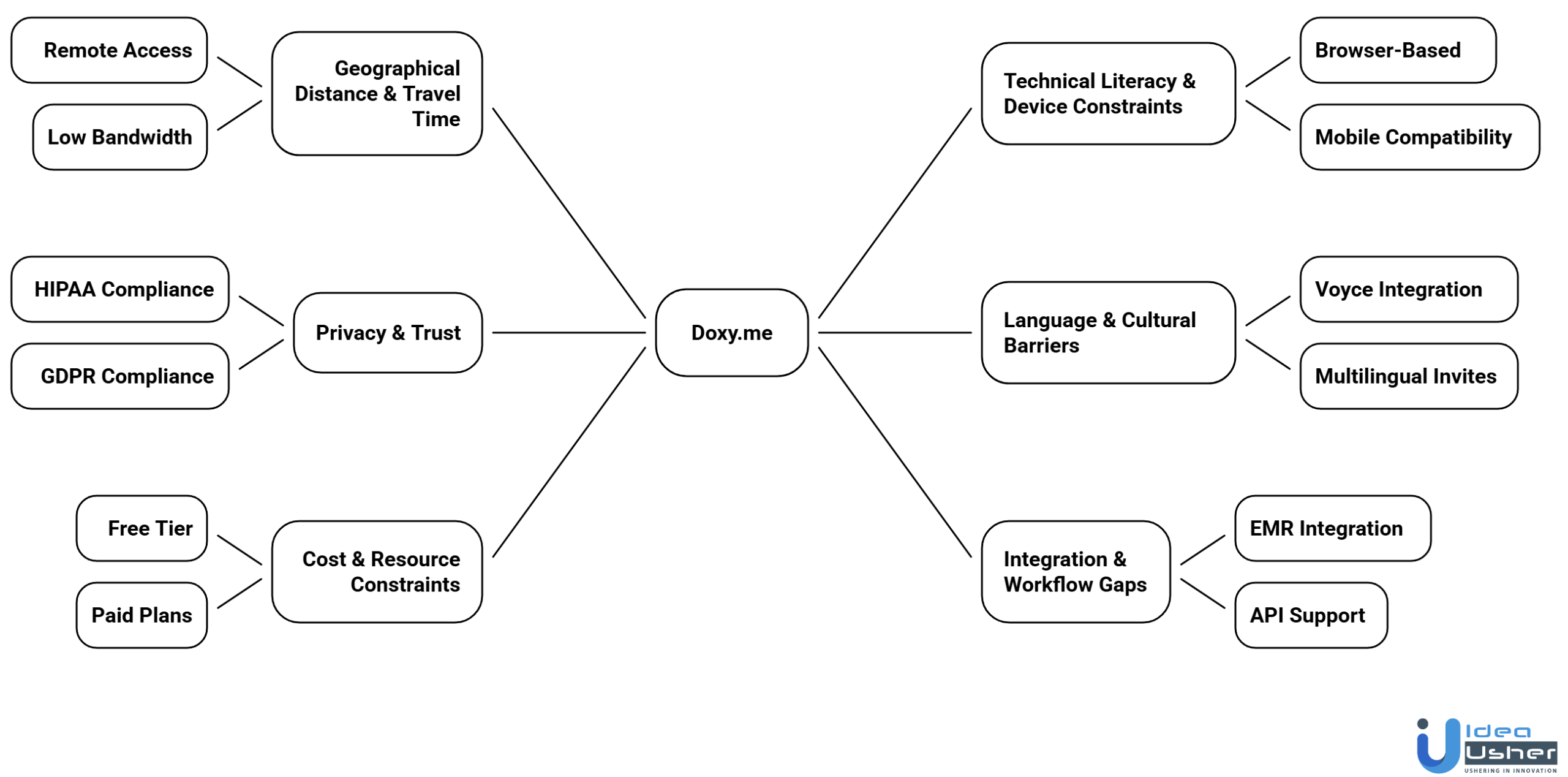
1. Geographical Distance & Travel Time
The platform eliminates the need for physical presence, allowing remote patients to access providers easily online. Its browser-based design works on low bandwidth, needing just a device, camera, mic and internet. This reduces missed appointments and expands care to those with limited transportation.
2. Technical Literacy & Device Constraints
Doxy.me runs in a browser, so patients avoid downloads or complicated setup. An invitation link provides instant access, with pre-call testing and one-click check-in reducing friction for non-technical users. Its mobile compatibility ensures access on smartphones and laptops.
3. Privacy & Trust
It complies with HIPAA and GDPR, ensuring secure, encrypted communication. BAAs are available for covered entities. The platform minimizes data storage, boosting transparency and patient confidence during virtual visits.
4. Language & Cultural Barriers
To foster inclusivity, Doxy.me integrates with Voyce, offering interpreters in over 240 languages. The interface supports localization and multilingual invites, enabling patients to receive instructions in their language. This enhances cross-cultural communication and care for diverse populations.
5. Cost & Resource Constraints
Doxy.me’s free tier helps small clinics and independent providers start using telehealth without a big financial commitment. Paid plans add features like file sharing, teleconsent, and group calls. This tiered approach lets providers upgrade as their telehealth needs grow.
6. Integration & Workflow Gaps
Doxy.me isn’t a full EMR but integrates well with Epic, Juvonno, and Luminello, syncing appointment links and patient data. It simplifies scheduling, payments, and documentation using APIs and Launch EHR tools, streamlining workflows and reducing admin tasks.
Key Features of a Secure Telemedicine Video Platform
A robust telemedicine video platform like Doxy.me must combine security, accessibility, and usability to ensure quality care. Below are the essential features that make a secure telemedicine video platform effective for both providers and patients.

1. End-to-End Encrypted Video & Audio Communication
Secure telemedicine platform like Doxy.me uses WebRTC technology for encrypted, browser-based video calls without software downloads. They comply with HIPAA, GDPR, and other regulations by protecting video streams and patient metadata, while advanced TLS/SSL protocols and AES‑256 encryption reduce cybersecurity risks.
2. Virtual Waiting Room with Smart Queue Management
Virtual waiting rooms offer personalized branding and instructions while providing real-time patient check-in updates. Automated queue management lets providers prioritize urgent consultations, improving efficiency and creating a more organized and patient-friendly experience.
3. Appointment Scheduling & Calendar Integration
Integrated scheduling tools allow providers to send appointment links via email or SMS. These platforms sync seamlessly with EMR/EHR systems and integrate with Google Calendar, Outlook, and others, helping minimize scheduling conflicts and improve clinic workflow.
4. EMR/EHR Integration for Seamless Workflow
Embedding video call capabilities directly into existing EMR/EHR systems streamlines workflows. Automatic session logging, patient record linking, and API integrations with major EMRs such as Epic, Cerner, and Juvonno ensure efficient documentation and continuity of care.
5. Secure Patient Authentication & Access
Secure telemedicine platforms offer one‑click patient joining without account creation to reduce technical barriers. Optional two‑factor authentication (2FA) adds an extra security layer, and role-based access ensures HIPAA compliance across clinic staff.
6. Payment & Billing Integration
Secure payment collection can happen within the video call or waiting room via gateways like Stripe. These systems support credit/debit cards, Apple Pay, Google Pay, and multiple currencies, with transparent pricing and payment history tracking for providers and patients.
7. Multi-Language Support & Interpretation Services
Integration with interpreter services such as Voyce allows access to over 240 languages. Interface localization and multilingual chat support make telemedicine more inclusive, improving accessibility for diverse patient populations.
8. Advanced Collaboration Tools
Collaboration tools enhance virtual care by enabling secure screen sharing, virtual whiteboards, and file transfers. Providers can educate patients, review diagnostics, and share reports or prescriptions in real time, improving engagement and understanding.
9. Real-Time Chat & Teleconsent
Secure text chat alongside video calls allows quick clarifications and instructions. Teleconsent features let patients sign consent forms digitally before or during sessions, streamlining workflows and ensuring compliance.
10. Analytics & Usage Insights
Analytics dashboards provide insights on appointment volumes, wait times, and patient engagement. Reporting tools support compliance and billing reconciliation, helping clinics optimize workflows and enhance the quality of care delivery.
11. Accessibility & Low-Bandwidth Optimization
The best telemedicine platforms work on desktops, tablets, and mobile devices without requiring downloads. Adaptive video quality ensures smooth connections in low-bandwidth settings, while accessibility features support visually or hearing-impaired patients.

Development Process of a Telemedicine Video Platform like Doxy.me
Building a secure telemedicine platform like Doxy.me requires a structured process that ensures compliance, performance, and usability. Our team follows a systematic approach from planning to continuous improvement to deliver a reliable telehealth solution.

1. Consultation
We begin by working closely with you the project scope and gather detailed requirements for the telemedicine video platform. Our developers ensure clarity on target users, compliance needs like HIPAA and GDPR, essential features, and technical integrations such as EHR/EMR systems.
2. System Architecture and Design
Our developers design a scalable, secure architecture for the telemedicine video platform, choosing the right tech stack for frontend, backend, and video streaming. We create optimized database structures and intuitive UI/UX wireframes to ensure accessibility, responsiveness, and a seamless user experience.
3. Core Development
We build the core features of the platform with precision. This includes a WebRTC-powered video calling engine, a robust appointment scheduling module, secure EMR integrations, and a reliable payment system to handle both patient payments and insurance billing efficiently.
4. Data Migration and Integration
Our team securely imports patient data during migration and carefully maps it to the new platform. We integrate existing EHR/EMR systems to ensure smooth workflows, data accuracy, and uninterrupted services for healthcare providers and patients.
5. Security Implementation and Compliance
We prioritize security by implementing end-to-end encryption, secure authentication like OAuth 2.0 and MFA, and role-based access control. Our developers conduct compliance audits and penetration testing to ensure the platform meets HIPAA, GDPR, and other regulatory requirements.
6. Testing and Quality Assurance
Our QA team runs comprehensive testing to guarantee the platform’s reliability. This includes functionality checks, load and stress testing for video calls, security vulnerability assessments, and compliance verification to ensure legal and operational safety.
7. Deployment and Go-Live
We deploy the telemedicine video platform on secure cloud infrastructure with auto-scaling capabilities. Our team monitors performance closely during launch, resolves issues rapidly, and provides healthcare providers with training for efficient adoption and smooth operations.
8. Maintenance and Continuous Improvement
Post-launch, we ensure continuous monitoring, bug fixing, and feature enhancements. Our developers incorporate AI-driven analytics, new integrations, and advanced telehealth functionalities over time to enhance usability, compliance, and competitive value.
Cost to Build a Secure Telemedicine Video Platform
Building a secure telemedicine video platform like Doxy.me requires careful planning, robust technology, and strict compliance with healthcare regulations. The development cost can vary widely based on features, security measures, and scalability requirements.
| Development Phase | Description | Estimated Cost |
| Consultation | Analyze requirements, define project goals, target audience, and core features while aligning with healthcare regulations. | $5,000 – $10,000 |
| System Architecture and Design | Plan scalable platform architecture and design UI/UX wireframes for seamless user experience. | $8,000 – $15,000 |
| Core Development | Build main features such as video consultations, scheduling, patient-doctor communication, and notifications. | $25,000 – $45,000 |
| Data Migration and Integration | Migrate patient records securely and integrate with EHR/EMR systems and third-party APIs. | $5,000 – $10,000 |
| Security Implementation and Compliance | Apply HIPAA/GDPR-compliant encryption, secure authentication, audit trails, and role-based access control. | $10,000 – $18,000 |
| Testing and Quality Assurance | Conduct functional, performance, and security testing to ensure reliable platform operations. | $6,000 – $12,000 |
| Deployment and Go-Live | Deploy platform on cloud servers, configure systems, and launch across devices and app stores. | $5,000 – $8,000 |
| Maintenance | Monitor performance, apply updates, optimize features, and implement user feedback for long-term reliability. | $6,000 – $14,000 |
Total Estimated Cost: $60,000 – $125,000
Note: This is an estimated cost breakdown to provide a clear understanding of the investment required for building a secure telemedicine video platform. Consult with IdeaUsher for tailored guidance and expert development support to bring your platform vision to life.
Tech Stack Recommendation for Secure Telemedicine Video Platform
Developing a secure, scalable telemedicine platform requires a tech stack that guarantees performance, compliance, scalability, and security. It must cover the frontend, backend, video calls, data storage, security, payments, and analytics.
1. Frontend Development
The frontend must deliver a seamless, intuitive, and responsive user experience, accommodating both patients and healthcare providers. It should also ensure cross-platform compatibility and accessibility.
- React.js: A component-based JavaScript library that enables rapid development of responsive user interfaces. It supports real-time updates and is highly maintainable.
- Angular: A full-featured framework offering built-in tools for form handling, routing, and state management, ideal for large-scale projects.
- Vue.js: Lightweight and flexible, Vue.js offers simplicity with high performance, ideal for developing fast-loading telemedicine interfaces.
2. Backend Development
The backend is the backbone of the telemedicine platform, handling user authentication, video call routing, data processing, and integrations securely and efficiently.
- Node.js: Offers high concurrency and scalability for real-time applications such as telemedicine. Its event-driven architecture makes it suitable for handling large volumes of simultaneous video sessions.
- Django: Python-based framework with strong security features and rapid development capabilities, suitable for healthcare platforms requiring compliance.
- Ruby on Rails: Great for fast prototyping and clean, maintainable code. It includes built-in features for database handling and security.
3. Real-Time Communication & Video Calling
Video calling is the core feature of a telemedicine platform, requiring ultra-low latency, secure streaming, and reliability.
- WebRTC: Open-source technology enabling real-time, encrypted video and audio streaming directly in browsers without plugins. Ideal for HIPAA-compliant telehealth calls.
- Agora.io: A managed real-time communication platform offering scalable video calling APIs, low latency, recording capabilities, and robust security features.
- Twilio Video SDK: Provides a customizable video calling solution with built-in encryption, multi-party calls, and cross-platform support.
4. Database & Storage
A secure, compliant, and scalable database structure is essential for storing sensitive patient records, appointments, and communication logs.
- PostgreSQL: A relational database offering strong data integrity, scalability, and compliance features, ideal for healthcare data.
- MySQL: Reliable relational database with proven performance and community support for enterprise-grade apps.
- MongoDB: A NoSQL database ideal for unstructured data such as video call logs, user preferences, and session transcripts.
- AWS S3 / Google Cloud Storage: Secure cloud storage with encryption and compliance certifications for storing medical records, consultation videos, and large media files.
5. Security & Compliance
Given the sensitivity of healthcare data, strong security measures and compliance with regulations such as HIPAA and GDPR are mandatory.
- OAuth 2.0 / OpenID Connect: Secure protocols for authentication and authorization, enabling single sign-on and better user control over permissions.
- JWT (JSON Web Token): Securely transmits information between the client and server for authentication and API access control.
- TLS / SSL Encryption: Protects all communications between the client and server, ensuring privacy and security.
6. Cloud Infrastructure & Deployment
Cloud infrastructure ensures scalability, uptime, and robust performance for telemedicine platforms.
- AWS: Provides secure cloud hosting with HIPAA-compliant services, scalable infrastructure, and integrated AI tools.
- Google Cloud Platform: Offers scalable cloud hosting with advanced analytics and AI tools, ideal for data-heavy telemedicine apps.
- Microsoft Azure: HIPAA-certified infrastructure with powerful integration capabilities for enterprise healthcare apps.
- Docker & Kubernetes: Containerization and orchestration tools that ensure smooth deployment, auto-scaling, and management of microservices.
Challenges & How to Overcome Them?
Developing a secure telemedicine video platform involves technical, regulatory, and user-experience challenges. Addressing these early ensures compliance, reliability, and adoption while protecting sensitive patient data. Below are the key challenges and how our developers tackle them.
1. Handling Video Lag & Connectivity
Challenge: Poor network conditions, high server loads, or inefficient streaming can degrade video quality, impacting patient-doctor interactions.
Solution: Our team integrates WebRTC with real-time communication APIs like Agora.io or Twilio, and implements adaptive bitrate streaming to adjust video quality automatically based on bandwidth conditions.
2. Secure Authentication & Access Management
Challenge: Weak authentication can expose sensitive medical records to unauthorized users, compromising patient privacy and trust.
Solution: We implement enterprise-grade authentication using OAuth 2.0, OpenID Connect, and Multi-Factor Authentication (MFA), ensuring secure access while maintaining smooth user experience for patients and providers.
3. Integrating with Existing EHR/EMR Systems
Challenge: Legacy EHR/EMR systems often use different standards, making integration complex and error-prone.
Solution: Our developers use APIs and HL7 FHIR standards to enable seamless data exchange, ensuring the platform communicates effectively without disrupting existing healthcare workflows.
4. Data Privacy & Encryption
Challenge: Telemedicine platforms handle extremely sensitive patient data, where breaches can damage reputation and violate laws.
Solution: We implement end-to-end encryption for video calls, secure cloud storage, and align all data management with industry-specific security standards, continuously monitoring for vulnerabilities.
5. Ensuring HIPAA & GDPR Compliance
Challenge: Telemedicine platforms must comply with HIPAA, GDPR, and local healthcare regulations, as any mismanagement of patient data can result in fines or legal consequences.
Solution: Our developers implement HIPAA-compliant cloud services, encrypt data at rest and in transit, adopt standardized compliance frameworks, and perform regular audits to maintain full regulatory alignment.
Conclusion
Building a telemedicine video platform like Doxy.me requires careful planning, reliable technology, and strict compliance with healthcare standards. From secure video communication to seamless integrations, every component plays a role in improving patient care and provider efficiency. As healthcare continues to move toward digital-first models, the demand for secure and user-friendly telehealth platforms will only increase. By investing in the right development approach, healthcare organizations can create solutions that strengthen trust, improve accessibility, and deliver meaningful, patient-centered virtual care experiences.
Why Choose IdeaUsher for Your Telemedicine Video Platform Development?
At IdeaUsher, we specialize in building secure, scalable telemedicine video platforms that prioritize patient privacy and seamless doctor-patient interaction. Whether you are a healthcare startup or a large provider, we help you deliver reliable virtual care solutions.
Why Work with Us?
- Healthcare & Technology Expertise: Our team ensures your platform meets industry standards, integrates with EHRs, and provides high-quality video consultations.
- Custom Telemedicine Solutions: We deliver end-to-end platforms tailored to your specific requirements, from appointment management to secure communication.
- Proven Experience: We have successfully developed HIPAA-compliant telemedicine platforms, helping clients streamline remote healthcare delivery.
- Scalable & Secure: Our platforms are designed to grow with your user base, ensuring long-term reliability and safety.
Explore our portfolio to see how we have helped healthcare providers to launch secure telemedicine platforms.
Reach out for a free consultation and bring your virtual care vision to life.
Work with Ex-MAANG developers to build next-gen apps schedule your consultation now
FAQs
A telemedicine video platform should offer high-quality video calls, secure patient authentication, real-time chat, appointment scheduling, electronic health record integration, and HIPAA-compliant data storage to ensure safety, efficiency, and seamless patient-provider interactions.
Data security can be ensured through end-to-end encryption, secure cloud storage, multi-factor authentication, regular vulnerability testing, and strict compliance with healthcare regulations, safeguarding sensitive patient information from breaches or unauthorized access.
Developing a telemedicine video platform requires WebRTC or similar streaming technology, secure backend servers, cloud hosting, APIs for EHR integration, and mobile-responsive design to ensure reliable, real-time communication across devices.
Telemedicine video platform like Doxy.me improves access to care, reduces travel time, enhances patient engagement, streamlines appointment management, and enables providers to monitor health efficiently, creating convenience, flexibility, and better healthcare outcomes.
